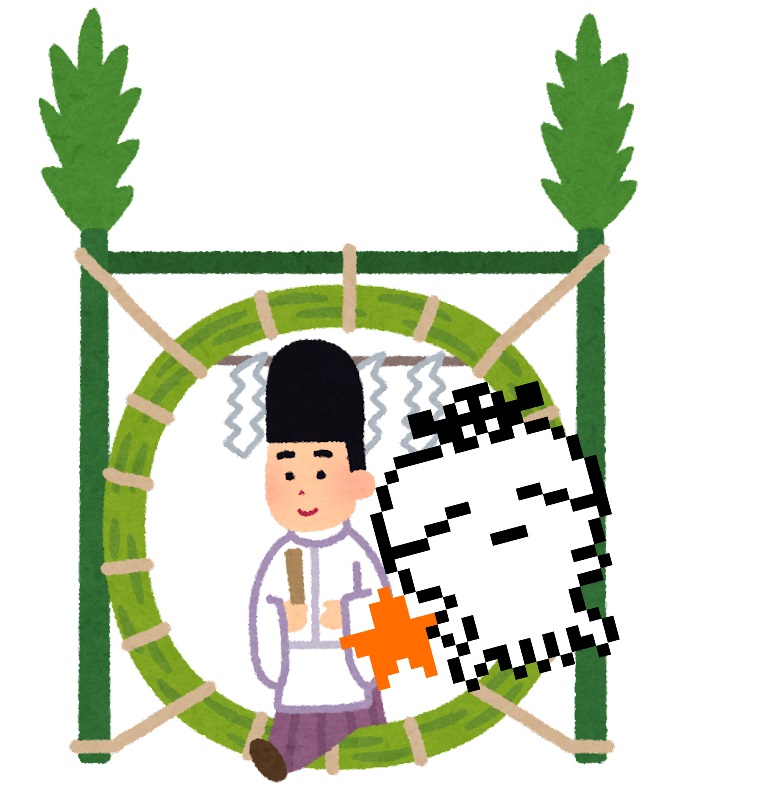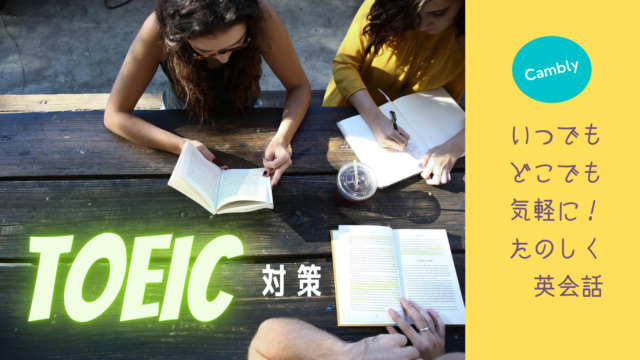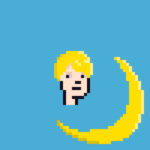今回は、日本の伝統的な文化や風習の中でもあまり知られていないイベント「茅の輪くぐり(Chinowa-Kuguri)」についての解説ブログです。
茅の輪くぐりは神事ですが、TOEICスコアアップや仕事のパフォーマンス向上を目指すなら、ぜひ体験してみるべきイベントだということがわかりました!
茅の輪くぐりが行われる時期は土地によって異なりますが、だいたい一年の折返し、真ん中あたりに実施されています。
なお「水無月」という和菓子は、この季節限定の和菓子。
できれば一年中、毎日食べたいくらいおいしいスイーツなんですが!
もう自分で作る?
♱⋰ ⋱✮⋰ ⋱♱⋰ ⋱✮⋰ ⋱♱⋰ ⋱✮⋰ ⋱♱⋰⋱✮⋰⋱
茅の輪くぐりとは
茅の輪(ちのわ)くぐりとは、夏の厄払いの風習の一つです。茅の輪は、茅(ちがや)という草で作られた輪で、神社や寺院などに設置されています。
茅の輪をくぐることで身体や心の穢れを祓い、健康や幸運を招くと信じられています。
茅の輪くぐりはスサノオノミコトの日本神話に起源があるといわれ、毎年6月30日に京都を始め各地の神社で執り行われる「夏越の祓(なごしのはらえ)」で行われる儀式であり、茅の輪くぐりが夏越の祓と同義で呼ばれるほど、日本に定着している風習です。
七夕(7月7日)や土用の丑の日(7月下旬)などに行われることもあり、福岡県の太宰府天満宮では、道真公の誕生日である7月24日と25日に茅の輪くぐりが行われます。
茅の輪くぐりの方法は地域や宗派によって異なりますが、唱え詞を唱えながら8の字に3度くぐり抜けるのが一般的です。
茅の輪くぐりをすることで、夏の暑さや疫病から身を守り、残り半年を元気に過ごすことができると言われていますよ。
ぐぐり……くぐりました~
♱⋰ ⋱✮⋰ ⋱♱⋰ ⋱✮⋰ ⋱♱⋰ ⋱✮⋰ ⋱♱⋰⋱✮⋰⋱
夏越の祓とは何?
夏越の祓(なごしのはらえ)とは、1年を半分にした6月の晦日(みそか)、旧暦6月30日に執り行われていた神事。
心身の穢れ(けがれ)や災厄の原因となる罪や過ちを、祓い清める儀式ですね。
「名越の祓(なごしのはらえ)」、「夏越神事(なごしのしんじ)」、「六月祓(みなづきばらえ)」とも呼ばれています。
また夏越の祓には、形代(かたしろ)と呼ばれる人形を用いた祓いも行われることがあります。
まとめ
茅の輪くぐりとは、茅で編んだ直径数メートルの輪をくぐり、心身を清めて厄災を払い、無病息災を祈願する夏越の祓を象徴する行事です。
茅の輪くぐりは、古くから日本人に親しまれている伝統的な風習なんですね。
お正月には初詣や年越しそばを食べる、節分には豆まきを行い、鬼を追い払う、お盆には、先祖の霊を迎えるために盆踊りが行われる。
他にも日本の伝統的な文化や風習はたくさんありますが、茅の輪くぐりを実際に体験された方は日本人にも少ないかもしれません。
無病息災で過ごすことが何より大切なことで、それによって集中力も上がってTOEICのスコアアップにも繋がります。
ぜひ一度、最寄りの茅の輪くぐりを体験してみてはいかがでしょうか?
♱⋰ ⋱✮⋰ ⋱♱⋰ ⋱✮⋰ ⋱♱⋰ ⋱✮⋰ ⋱♱⋰⋱✮⋰⋱
What’s 茅の輪くぐり
This time, I’d like to explain a traditional Japanese event called “Chinowa-Kuguri” that is not widely known even in Japan.
Chinowa-Kuguri is a ritual, but I found out that it is an event worth experiencing if you aim to improve your TOEIC score or work performance.
The timing of Chinowa-Kuguri varies depending on the region, but it is generally held around the midpoint of the year, approximately at the halfway mark.
By the way, there is a traditional Japanese sweet called “Minazuki” that is only available during this season. It’s so delicious that I wish I could eat it all year round…
♱⋰ ⋱✮⋰ ⋱♱⋰ ⋱✮⋰ ⋱♱⋰ ⋱✮⋰ ⋱♱⋰⋱✮⋰⋱

What is Chinowa-Kuguri?
Chinowa-Kuguri is one of the customs for warding off misfortune during the summer. It involves passing through a ring made of grass called “Chinowa,” which is installed at shrines and temples.
It is believed that passing through the Chinowa ring purifies the body and mind from impurities and invites good health and fortune.
Chinowa-Kuguri is said to have originated from the Japanese myth of the god Susanoo-no-Mikoto, and it is a ritual performed during the “Nagoshi no Harae,” which takes place every year on June 30th at various shrines across Japan, starting from Kyoto. The tradition of Chinowa-Kuguri has become so established in Japan that it is often synonymous with Nagoshi no Harae.
It is also performed on Tanabata (July 7th) and “Doyo no Ushi no Hi” (late July). In Fukuoka Prefecture’s Dazaifu Tenmangu Shrine, Chinowa-Kuguri takes place on July 24th and 25th, which is the birthday of Michizane Sugawara.
The method of Chinowa-Kuguri varies depending on the region and sect, but generally, it involves passing through the ring three times in a figure-eight pattern while reciting certain chants.
It is said that performing Chinowa-Kuguri protects one from the summer heat and epidemics, allowing them to spend the remaining half of the year in good health.
♱⋰ ⋱✮⋰ ⋱♱⋰ ⋱✮⋰ ⋱♱⋰ ⋱✮⋰ ⋱♱⋰⋱✮⋰⋱

What is Nagoshi no Harae?
Nagoshi no Harae is a ritual conducted on the last day of June (misoka) and the 30th day of the old calendar (June 30th) when the year is divided in half. It is a ceremony to purify and cleanse the impurities and sins that could cause misfortune for the mind and body.
It is also known as “Nagoshi no Harae,” “Nagoshi Shinji,” and “Minazuki Barae.”
In Nagoshi no Harae, there is also a purification ritual involving using a doll called “Katashiro.”
♱⋰ ⋱✮⋰ ⋱♱⋰ ⋱✮⋰ ⋱♱⋰ ⋱✮⋰ ⋱♱⋰⋱✮⋰⋱
Summary
Chinowa-Kuguri is a symbolic event representing the Nagoshi no Harae, a ritual in which one passes through a several-meter-wide ring made of Chinowa grass to cleanse their mind and body, ward off misfortune, and pray for good health. This tradition has been beloved by the Japanese people since ancient times.
In Japan, there are many other traditional customs and cultural practices, such as Hatsumode (the first shrine visit of the New Year) and eating Toshikoshi soba on New Year’s Eve, throwing beans during Setsubun to drive away evil spirits, and Bon Odori dancing to welcome ancestral spirits during the Obon festival.
Although there are many such customs in Japan, experiencing Chinowa-Kuguri might be rare even for Japanese individuals. Ensuring good health is the most important thing, and it can also lead to improved concentration and a higher TOEIC score.
I highly recommend trying out the nearest Chinowa-Kuguri event. How about giving it a try?
♱⋰ ⋱✮⋰ ⋱♱⋰ ⋱✮⋰ ⋱♱⋰ ⋱✮⋰ ⋱♱⋰⋱✮⋰⋱
最後までお読みいただきありがとうございました。
この記事があなたのお役に立ちましたら幸いです。
ではノシ

















